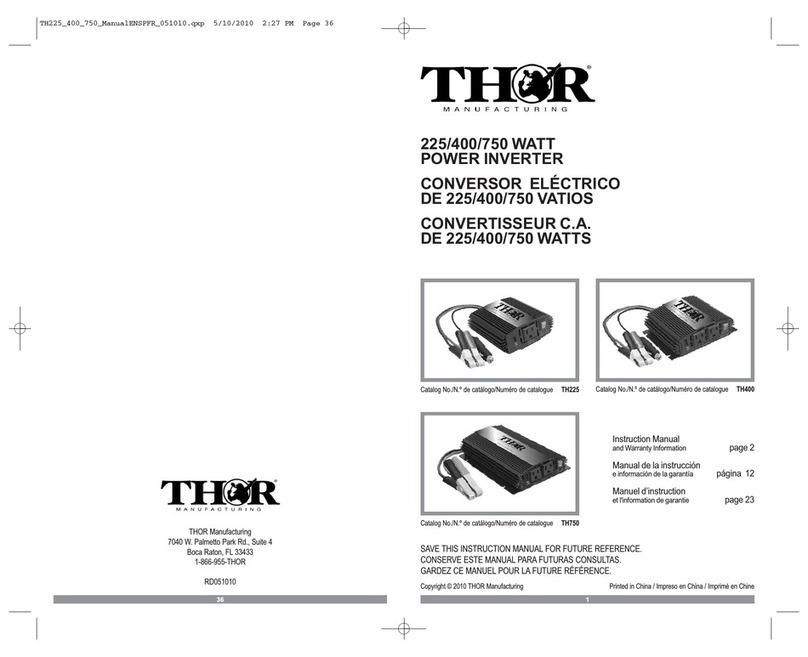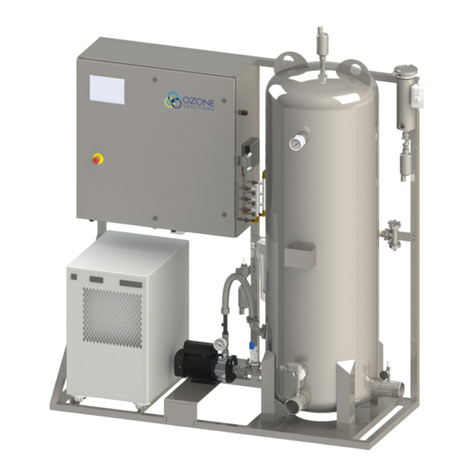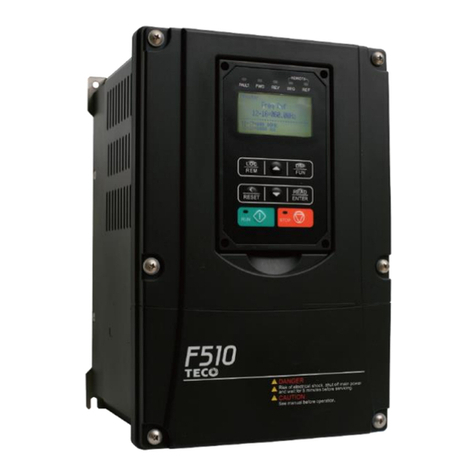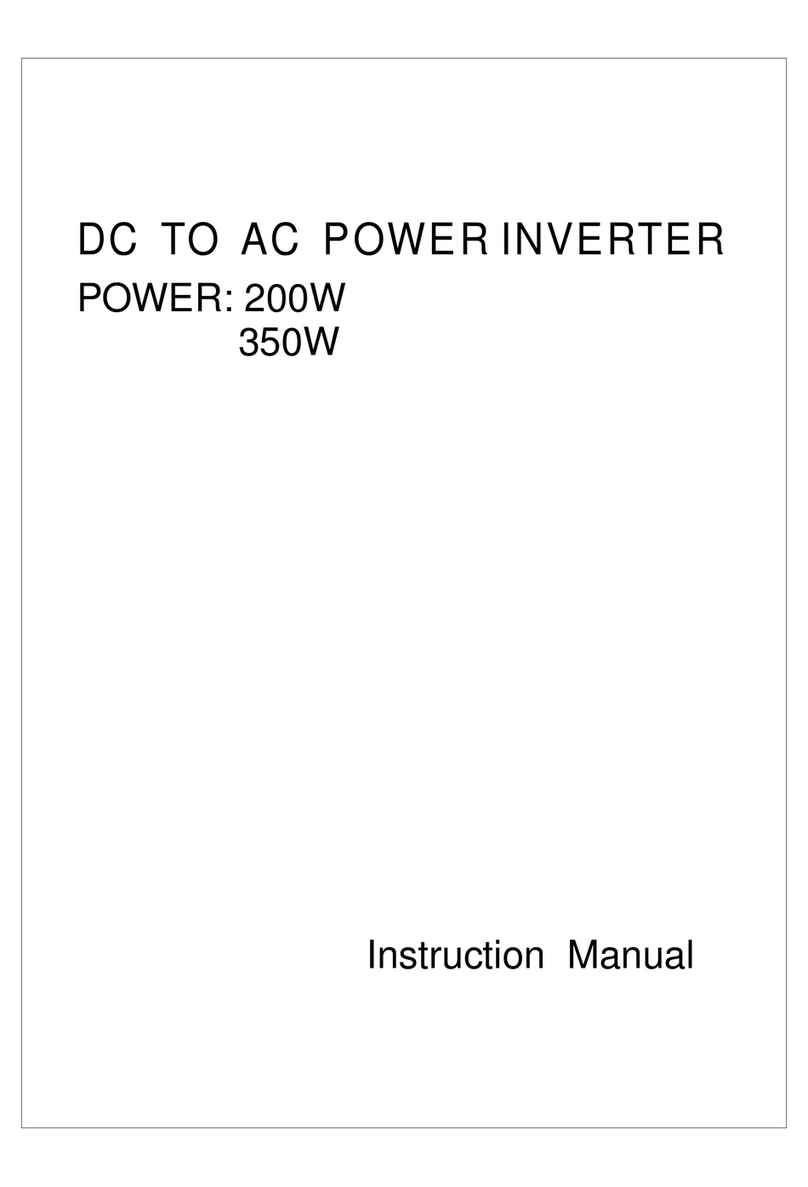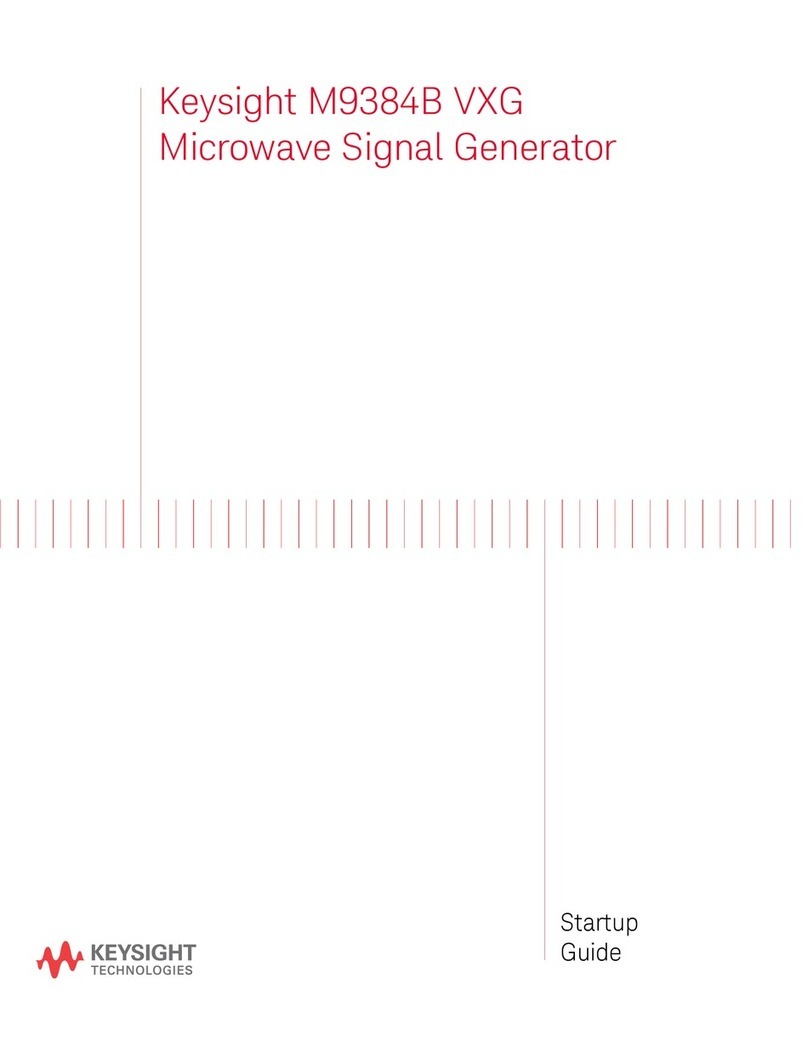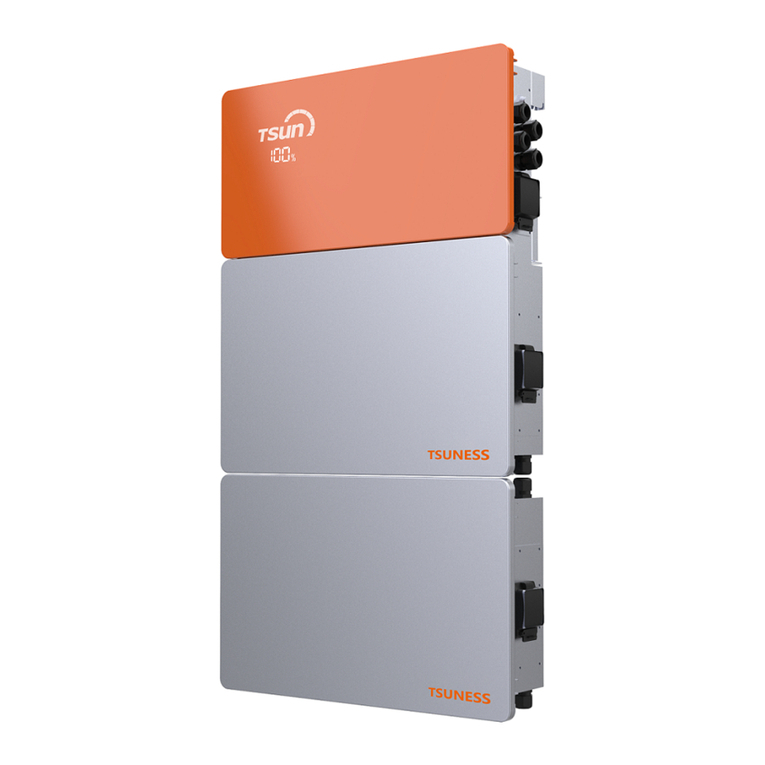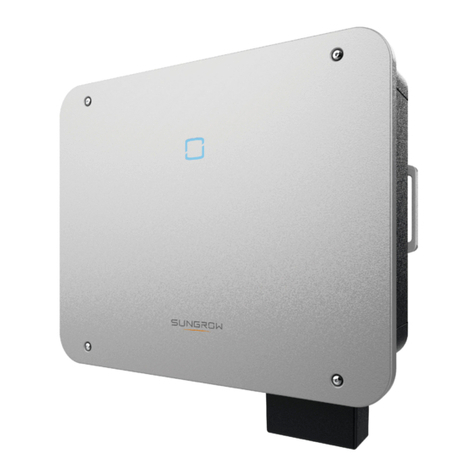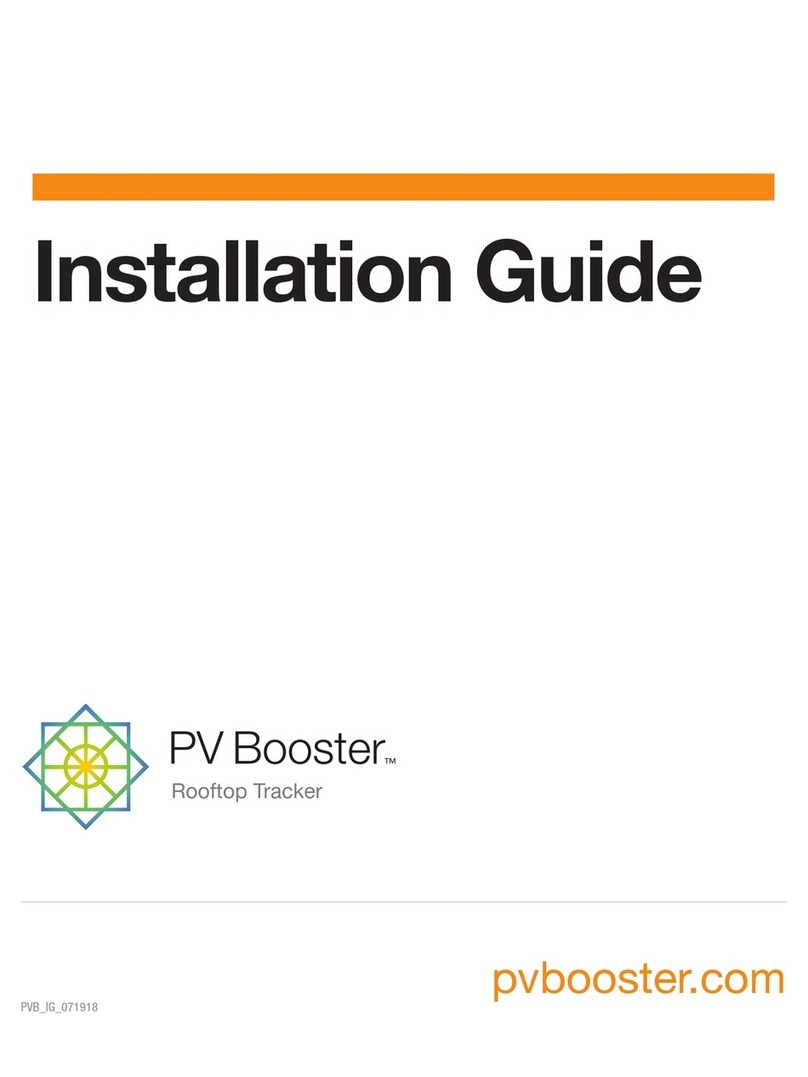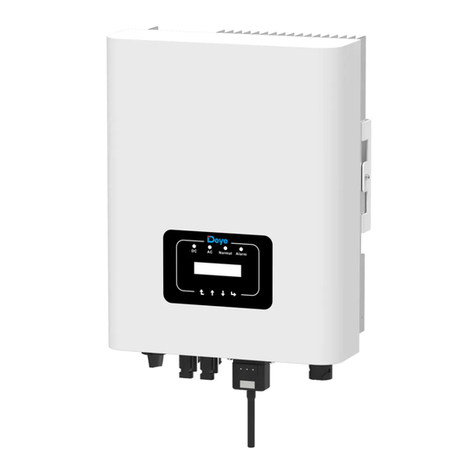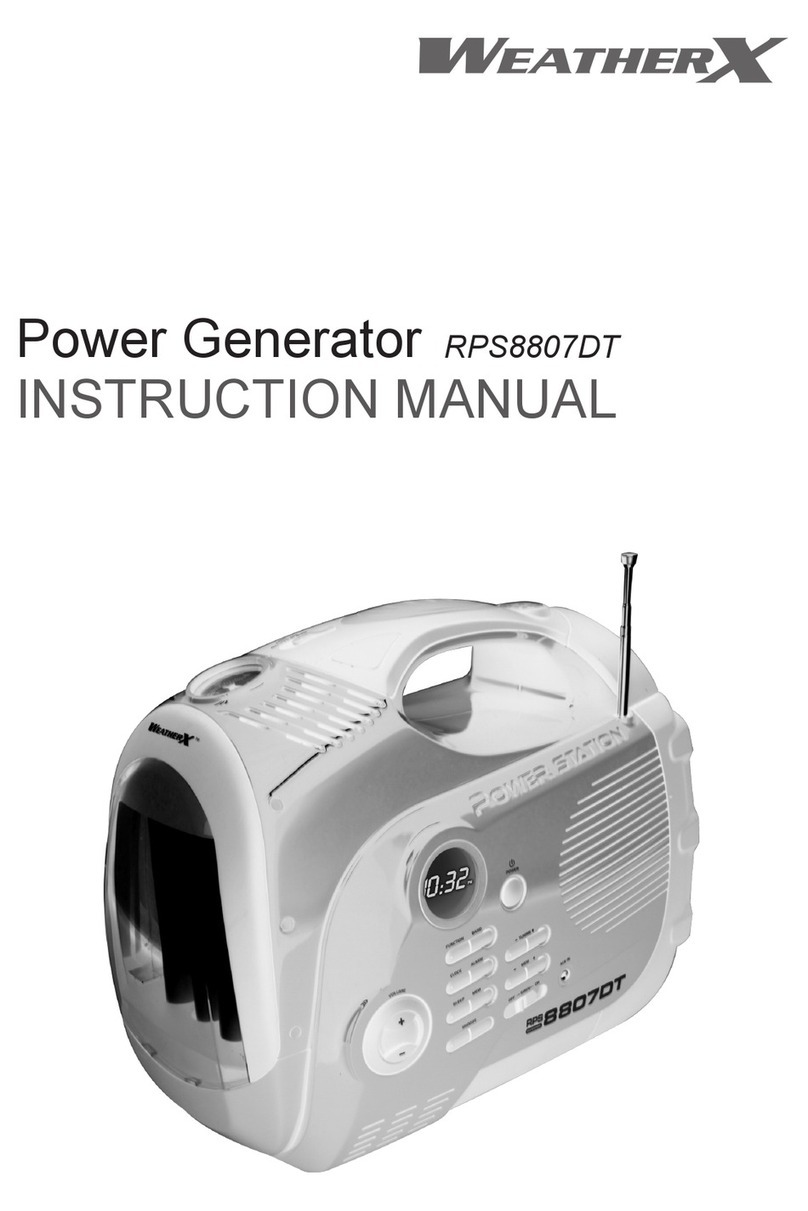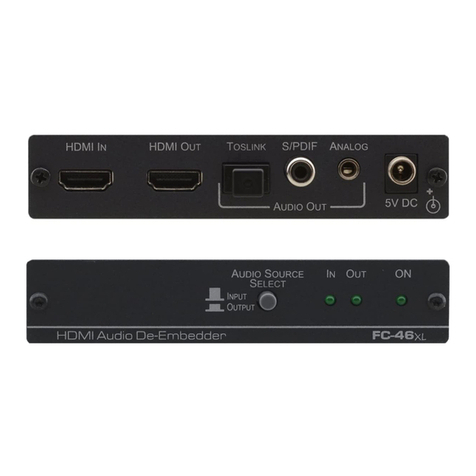THOR THPS 1000 Series User manual

THPS 1000, 2000 & 3000
Series
Pure Sine Wave Inverter
User’s Manual

1. Important Safety Instructions
1-1. General SafetyPrecautions
1-1-1. Do not expose the Inverter to rain, snow, spray, bilge or dust.
To reduce risk of hazard, do not cover or obstruct the ventilation
openings. Do not install the Inverter in a zero-clearance compartment.
Overheating may result.
1-1-2. To avoid a risk of fire and electronic shock, make sure that existing
wiring is in good electrical condition and not undersized.
Do not operate the Inverter with damaged or substandard Wiring.
1-1-3. There are some components in the inverter can cause arcs and sparks.
To prevent from fire or explosion, do not put batteries, flammable
materials, or anything should be ignition–protected around the inverter.
1-2. Precautions When Working with Batteries
1-2-1. If battery acid contacts skin or clothing, you shall wash it out with soap
and water immediately. If battery acid contacts your eyes, you shall
wash it out with cold running water for at least 20 minutes and get
medical attention immediately.
1-2-2. Never smoke or make a spark or flame in the vicinity of the battery or
the engine.
1-2-3. Do not drop a metal tool on the battery. The resulting spark or
short-circuit on the battery of other electrical part may cause an
explosion.
1-2-4. Remove personal metal items such as rings, bracelets, necklaces,
and watches when operating with a lead-acid batteries.
Doing so may cause short circuit and very high temperature, which can
melt metal items and even burn you.
WARNING!
Before using the Inverter, read and save the safety
instructions.

2. Features
Pure sine wave output (THD <3%)
Output frequency:50 / 60Hz switch selections
Input & output fully isolated design
Power Saving Mode to conserve energy
High efficiency 89~94%
Driving highly reactive & capacitive loads at start moment
Tri-Color indicators show input voltage & output load level
Loading controlled cooling fan
Advanced microprocessor
Protection:Input low voltage Overload Short circuit
Low battery alarm Input over voltage Over temperature
2-1. Application
2-1-1. Power tools – circular saws, drills, grinders, sanders, buffers, weed
and hedge trimmers, air compressors, etc.
2-1-2. Office equipment – computers, printers, monitors, facsimile machines,
scanner, etc.
2-1-3. Household appliances – vacuum cleaners, fans, fluorescent and
incandescent lights, shavers, sewing machines.
2-1-4. Kitchen appliances – coffee makers, blenders, ice markers, toasters,
etc.
2-1-5. Industrial equipment – metal halide lamp, high – pressure sodium lamp,
etc.
2-1-6. Home entertainment electronics – television, VCRs, video games,
stereos, musical instruments, satellite equipment, etc.

SpecificationModel No.
Item THPS-1000-12 THPS-1000-24 THPS-1000-48 THPS-1000-212 THPS-1000-224 THPS-1000-248
W0001rewoPtuptuOsuounitnoC
W0011rewoPtuptuOmumixaM
W0002)xaM(gnitaRegruS
Input voltage 12V 24V 48V 12V 24V 48V
OutputVoltage 100 / 110 / 120V +/- 5% 220 / 230 / 240V +/- 3%
Frequency
(Switch Selectable) 50 / 60Hz +/-0.05%
)%3<DHT(evaWeniSeruPmrofevaWtuptuO
Efficiency (full load) Max. *189.0% 92.0% 93.0% 91.0% 94.0% 95.0%
No Load Current Draw (Max.) 1.43A 0.75A 0.38A 1.25A 0.65A 0.35A
Stand-By Current Draw (Max.) 0.25A 0.15A 0.09A 0.25A 0.15A 0.09A
Input Voltage Regulation 10.5-15
VDC
21.0-30
VDC
42-60
VDC
10.5-15
VDC
21.0-30
VDC
42-60
VDC
InputLevel Indicator Red / Orange / Green LED
Load Level Indicator
DELdeRrotacidnIeruliaF
Protection Overload, Short Circuit, Reverse Polarity(Fuse),
Over / Under Input Voltage, Over Temperature.
Remote Control Units TH-R6 / TH-R8 Optional
1-05906NE854LUnoitacifitreCytefaS
AssalCCCFCME
EN55022: 1997
EN55024: 1997
EN61000-3-2: 1998
EN61000-3-3: 1995
e-mark
e13 022694
Operating Temperature Range 0 - 40
Storage Temperature Range -30 to 70
nafgniloocdellortnocgnidaoLgnilooC
Dimensions 340(L)*182(W)*88(H)mm / 13.39(L)*7.17(W)*3.46(H) Inch
.sbL8.8/gk4thgieW
Note: The specifications are subject to change without notice.
℃
℃℃

SpecificationModel No.
Item THPS-2000-12 THPS-2000-24 THPS-2000-48 THPS-2000-212 THPS-2000-224 THPS-2000-248
W0002rewoPtuptuOsuounitnoC
W0022rewoPtuptuOmumixaM
W0004)xaM(gnitaRegruS
Input voltage 12V 24V 48V 12V 24V 48V
OutputVoltage 100 / 110 / 120V +/- 5% 220 / 230 / 240V +/- 3%
Frequency
(Switch Selectable) 50 / 60Hz +/-0.05%
)%3<DHT(evaWeniSeruPmrofevaWtuptuO
Efficiency (full load) Max. *189.0% 92.0% 93.0% 91.0% 94.0% 95.0%
No Load Current Draw (Max) 2.8A 1.5A 0.7A 2.64A 1.32A 0.65A
Stand-By Current Draw (Max) 0.60A 0.30A 0.15A 0.60A 0.25A 0.15A
Input Voltage Regulation 10.5-15
VDC
21.0-30
VDC
42-60
VDC
10.5-15
VDC
21.0-30
VDC
42-60
VDC
InputLevel Indicator Red / Orange / Green LED
Load Level Indicator
DELdeRrotacidnIeruliaF
Protection Overload, Short Circuit, Reverse Polarity(Fuse),
Over / Under Input Voltage, Over Temperature.
Remote Control Units TH-R6 / TH-R8 Optional
Safety Certification Meet UL458 EN60950-1
AssalCCCFCME
EN55022: 1997
EN55024: 1997
EN61000-3-2: 1998
EN61000-3-3: 1995
e-mark
e13 22846
Operating Temperature Range 0 - 40 ℃
Storage Temperature Range -30℃to 70℃
CoolingLoading controlled cooling fan ( 65℃ON , 45℃OFF)
Dimensions 368(L)*209(W)*166(H)mm / 14.49(L)*8.23(W)*6.53(H) Inch
.sbL8.91/gk9thgieW
Note: The specifications are subject to change without notice.

SpecificationModel No.
Item THPS-3000-12 THPS-3000-24 THPS-3000-48 THPS-3000-212 THPS-3000-224 THPS-3000-248
W0003rewoPtuptuOsuounitnoC
W0033rewoPtuptuOmumixaM
W0006)xaM(gnitaRegruS
Input voltage 12V 24V 48V 12V 24V 48V
OutputVoltage 100 / 110 / 120V +/- 5% 220 / 230 / 240V +/- 3%
Frequency
(Switch Selectable) 50 / 60Hz +/-0.05%
)%3<DHT(evaWeniSeruPmrofevaWtuptuO
Efficiency (full load) Max. *188.0% 91.0% 92.0% 90.0% 93.0% 94.0%
No Load Current Draw (Max) 3.0A 1.6A 0.8A 2.8A 1.5A 0.7A
Stand-By Current Draw (Max) 0.55A 0.35A 0.19A 0.55A 0.35A 0.19A
Input Voltage Regulation 10.5-15
VDC
21.0-30
VDC
42-60
VDC
10.5-15
VDC
21.0-30
VDC
42-60
VDC
InputLevel Indicator Red / Orange / Green LED
Load Level Indicator
DELdeRrotacidnIeruliaF
Protection Overload, Short Circuit, Reverse Polarity(Fuse),
Over / Under Input Voltage, Over Temperature.
Remote Control Units TH-R6 / TH-R8 Optional
Safety Cert. Meet UL458 EN60950-1
AssalCCCFCME
EN55022: 1997
EN55024: 1997
EN61000-3-2: 1998
EN61000-3-3: 1995
e-mark
e13 22845
Operating Temperature Range 0 - 40 ℃
Storage Temperature Range -30℃to 70℃
nafgniloocdellortnocgnidaoLgnilooC
Dimensions 398(L)*209(W)*166(H)mm / 15.67(L)*8.23(W)*6.53(H) Inch
.sbL22/gk8.9thgieW
Note: The specifications are subject to change without notice.
*1 : This test condition is normal DC input (13.5V) and Temperature 25℃.

2-3. Mechanical Drawings
REM OT E
PORT
CHASSIS
GRO UN D
THPS1000 340.00 [13.39]
THPS1000 43.5 [1.71]
196.00 [7.72]
THPS1000 88.00[3.46]
THPS1000 182.00[7.17]
THPS1000 154.00 [6.06]
S3
S2
PWR.
S AV .
I
OS1
LOAD
LEVEL
INPUT
LEVEL
S4
ST A TU S
FREQ.
10 00 W
Pure Sine Wave Power Inverter
POS(+)NEG(-)
DC INPUT
REVERSE POLARITY
WILL DAMAGE UNIT
PURE SI NE WAVE IN VERT ER
ACOU TP UT
NONO
REMOTE
OFF
I
0

245.00 [9.65]
56.00 [2.20]
THPS2000 368.00 [14.49]
THPS3000 398.00 [15.67]
Pure Sine Wave Power Inverter
166.00 [6.53]
209.00 [8.23]
AC OUTPUT
PURE SINE WAVE INVERTER
S4FREQ.
S2
S1
S3 PWR.
SAV.
OI
0REMO.
LOAD
LEVEL
STATUS
INPUT
LEVEL
OFF
ON
I
177.00 [6.97]
200 0W

3. Introduction
This power inverter series is one of the most advanced line of mobile AC power
systems.
To get the most effective power inverter, it must be installed and used properly.
Please read the instructions of this manual before you install and operate this
model.
3-1. Front Panel Operations:
3-1-1. Front view:
PURE SINE WAVE INVERTER
AC OUTPUT
OFF
REMOTE
I
0
ON
S1
PWR.
SAV.
OI
INPUT
LEVEL
FREQ.
STATUS
S4
LOAD
LEVEL
S2
S3 THPS-1000
0
S4
S3
S1
S2
O
THPS-2000
FREQ.
PWR.
SAV.
LOAD
LEVEL
STATUS
INPUT
LEVEL
I
AC OUTPUT
PURE SINE WAVE INVERTER
REMO.
ION
OFF
3-1-2. ON / OFF/ REMOTE (Main) switch:
a. Before installing the inverter, you need to ensure the main switch
must be “OFF”.
b. Before using the remote unit, you need to ensure the main switch
must be “ REMOTE”.
THPS-3000

3-1-3. Input Level:Display Input Voltages
LED Status DC 12V DC 24V DC 48V
REDSlow Blink 10.3~10.6 20.5~21.2 40.8~42.4
RED 10.6~11.0 21.2~21.8 42.4~43.5
ORANGE 11.0~12.1 21.8~24.1 43.5~48.1
GREEN 12.1~14.2 24.1~28.6 48.1~56.3
ORANGE Blink 14.2~15.0 28.6~30.0 56.3~59.6
OVER RED Blink 15.0 30.0 59.6
3-1-4. Load Level:Display AC Loads (Watts)
LED status DARK GREEN ORANGE RED RED BLINK
THPS-1000~80W 80 ~ 330W 330 ~ 750W 750 ~ 960W Over 960W
THPS-2000~ 160W 160 ~ 660W 660 ~ 1500W 1500 ~ 1920W Over 1920W
THPS-3000 ~ 240W 240 ~ 990W 990 ~ 2250W 2250 ~ 2880W Over 2880W
3-1-5. AC Frequency:Selected by “S4” Dip Switch
Frequency S4
FFOZH05
NOZH06

3-1-6. Status:Display Power & Fault Status
Green LED LED Signal Status
Solid Power OK
Slow Blink Power Saving
Red LED LED Signal Status
PVOknilBtsaF
PVUknilBwolS
Intermittent Blink OTP
PLOdiloS
3-1-7. Power Saving Mode: Power Saving Mode is adjustable and
set by the Dip Switches, S1, S2 and S3 on the front panel.
Example: With the watt setting at 15W, a 15W↑load will make the
inverter operate normally, a 15W↓load will enter into the Power
saving mode.
THPS-1000 THPS-2000
THPS-3000 S1 S2 S3
DISABLE DISABLE OFF OFF OFF
20W 40W ON OFF OFF
40W 80W OFF ON OFF
55W 125W ON ON OFF
75W 170W OFF OFF ON
95W 210W ON OFF ON
115W 245W OFF ON ON
135W 280W ON ON ON

3-1-8. AC outlets (available):
Australia / New Zealand
IEC-2
Universal
HARD WIRE
United Kingldom
IEC-1
North America (GFCI)
NEMA 5-15R
NEMA 5-20R
Continental European

3-2. Rear Panel Operations:
THPS-1000
3-2-1. Remote Port:
The THPS Series Inverter is compatible with any of the remote
controllers,THR-6, THR-8.
Before using the remote unit, you need to ensure the main switch is in
the “ REMOTE” position and the input voltage of the power inverter is
the same as it of the remote unit.
3-2-2. Fan Ventilation:
Be sure to keep it a distance (at least 1 inch) form surrounding things.
THPS-2000
THPS-3000
REMOTE
PORT
CHASSIS
GROUND
NEG(-)
POS(+)
WARNING:
DC INPUT
REVERSE POLARITY
WILL DAMAGE UNIT
SHOCK HAZARD.
DO NOT OPEN. NO
USER SERVICEABLE
PARTS INSIDE.
POS(+) NEG(-)
DC INPUT
REVERSE POLARITY
WILL DAMAGE UNIT
REMOTE
PORT
CHASSIS
GROUND

3-2-3. DC Input Terminal:
Connect DC input terminal to 12V / 24V / 48V battery or the other
power sources.
【+】represents positive, and【-】represents negative. Reverse
polarity connection will blow the internal fuse and may damage the
inverter permanently.
ModelDC Input Voltage
Minimum Maximum
12 V 10.5 15.0
24 V 21.0 30.0
48 V 42.0 60.0
3-2-4. Use wire # 8 AWG to connect Chassis ground with vehicle chassis.
3-3. ProtectionsFeatures:
Model
DC Input (VDC) Over Temperature Protection
Over Voltage Under
Voltage
Alarm
Under
Voltage INTERIOR HEAT SINK
Shut-
down Restart Shut-
down Restart Shut-
down Restart Shut-
down Restart
12 V 15.3V 14.3V 11.0V 10.2V 12.7V
70℃45℃90℃60℃
24 V 30.6V 28.6V 22.0V 20.3V 25.2V
48V 61.0V 57.2V 44.0V 40.8V 49.7V
WARNING!
Operating the inverter without a proper ground
Connection may cause an electrical hazard.

3-4. Installation:
The power inverter should be installed in an environment that meets the
following requirements:
3-4-1. Dry – Do not allow water to drip on or enter into the inverter.
3-4-2. Cool – Ambient air temperature should be between 0℃and 40℃, the
cooler the better.
3-4-3. Safe – Do not install the inverter in a battery compartment or other
areas where flammable fumes may exist, such as fuel storage areas or
engine compartments.
3-4-4. Ventilated –Keep the inverter a distance (as least 1 inch) away from
surrounding things. Ensure the ventilation shafts on the rear and the
bottom of the unit are not obstructed.
3-4-5. Dust – Do not install the Inverter in a dusty environments
The dust can be inhaled into the unit when the cooling fan is working.
3-4-6. Close to batteries – Avoid excessive cable lengths. Do not install the
Inverter in the same compartment as batteries.
Use the recommended wire lengths and sizes (see section 3-5).
Do not mount the Inverter where it will be exposed to the gases
produced by the battery. These gases are very corrosive, and
prolonged exposure will damage the Inverter.
WARNING!
Shock Hazard. Before proceeding further, carefully
check that the Inverter is NOT connected to any
batteries, and that all wiring is disconnected from any
electrical sources. Do not connect the output terminals
of the Inverter to an incoming AC source.

3-5. DC Wiring Connections:
Follow this procedure to connect the battery cables to the DC input terminals
of the Inverter. The cables should be as short as possible (less than 10 feet
/ 3 meters ideally) and large enough to handle the required current in
accordance with the electrical codes or regulations applicable to the
installation.
Cables that are not an adequate gauge (too narrow) or too long will
deteriorate inverter performance such as poor surge capability and frequent
low-input voltage warnings and shutdowns.
These low input voltage warnings are due to DC voltage drop across the
cables from the inverter to the batteries.
The longer and narrower the cables, the greater the voltage drop.
Increasing DC cable size helps improve the situation. Thor Mftg. Inc.
recommends the following cables for optimum inverter performance.
(Apply both 120V and 230V versions )
Model No Wire AWG Inline Fuse
THPS-1000-12 # 2 150 A
THPS-1000-24 # 4 80A
THPS-1000-48 # 6 40 A
THPS-2000-12 # 2/0 250 A
THPS-2000-24 # 1/0 125 A
THPS-2000-48 # 2 70 A
THPS-3000-12 # 4/0 400 A
THPS-3000-24 # 2/ 200 A
THPS-3000-48 # 1/0 100 A

3-5-1. Connect the cables to the power input terminals on the rear panel of
the inverter. The red terminal is represents positive (+) and black
terminal represents negative (-). Insert the cables into the terminals
and tighten the screw to clamp the wires securely.
Also, use only high quality copper wire and keep cable length short, a
maximum of 3 - 6 feet.
WARNING!
The installation of a fuse must be on a positive cable.
Failure to place a fuse on “+” cables running between
the inverter and battery may cause damage to the
inverter and will void warranty.
WARNING!
Ensure all the DC connections are tight (torque
to 9 – 10 ft-lbs, 11.7 – 13 Nm). Loose connections
may cause overheat and fire.
Battery to inverter cable connection
Do not placeanything between
battery cable lug and terminal surface.
Assemble exactly as shown.
M8 SCREW
RING TERMINAL
PVC WIRE
AWG#2-#6

PORT
CHASSIS
GROUND
REMOTE
NEG(-)
POS(+)
DC INPUT
INLINE FUSE
THPS-1000
THPS-2000
THPS-3000
INLINE FUSE
REVERSE POLARITY
WILL DAMAGE UNIT
SHOCK HAZARD.
DO NOT OPEN. NO
USER SERVICEABLE
PARTS INSIDE.
WARNING:
DC INPUT POS(+)
CHASSIS
GROUND
NEG(-) REMOTE
PORT
Battery to inverter cable connection
Do not place anything between
battery cable lug and terminal surface.
Assemble exactly as shown.
BATTERY
BATTERY
M8 NUT
SPRING WASHER
RING TERMINAL
PVCWIRE
WASHER
PLASTIC COVER
(BLACK)
PLASTIC COVER
(RED)

3-6. AC Safety GroundingΚ
The AC output ground wire should go to the grounding point for your loads
( for example, a distribution panel ground bus ).
3-6-1. Neutral Grounding (GFCI’S)Κ
3-6-1-1.120V modelsΚThe neutral conductor of the AC output circuit
of the Inverter is automatically connected to the safety
ground during inverter operation. This conforms to National
Electrical Code requirements that separately derived from AC
sources (such as inverters and generators) which have their
neutral conductors tied to ground in the same way as the
neutral conductors from the utility tied to ground at the AC
breaker panel. For models configured with a transfer relay,
while AC utility power is present and the Inverter is in bypass
mode, this connection (the neutral of the Inverter’s AC output
to input safety ground) is not present so that the utility
neutral is only connected to ground at your breaker panel,
as required.
Ground Fault Circuit Interrupters (GFCI)Κ
Installations in Recreational Vehicles (for North American approvals) will
require GFCI protection of all branch circuit connected to the AC output of
the hardwire terminal equipped with Inverter. In addition, electrical codes
require GFCI protection of certain receptacles in residential installations.
While the pure sine wave output of the Inverter is equivalent tothe
waveformprovided by utilities, compliance with UL standards requires us to
test and recommend specific GFCI.
Thor has tested the following GFCI – protected 20A receptacles and found
that they functioned properly when connected to the output of the Inverter.

3-7. Inverter Operation:
To operate the power inverter, use the ON / OFF switch on the Front panel to
turn the power on. Then the power inverter is ready to deliver AC power to
your loads. If there is several loads use, turn them on separately after the
inverter is “ON” in order to prevent OVP resulted from the surge power.
3-7-1. Set the power switch to “ON” position and the buzzer will send out
“Beep” sounds at the moment. Then the inverter will make self-
diagnosis, and the LED’s indicators will also appear various colors.
Finally the buzzer will “Beep” again and the Input Level and Status
LED indicators will turn to “Green” color, then the inverter starts to
work successfully.
3-7-2. Set the power switch to the OFF position, then the inverter stops and
all the lights go Off.
3-7-3. Set the power inverter switch to ON position and turn the test load On.
The inverter should supply power to the load. If you plan to
accurately measure the true output r.m.s. voltage of the inverter, a
meter such as FLUKE 45 BECKMAN 4410 or TRIPLETT 4200 must be
used.
This manual suits for next models
2
Table of contents
Other THOR Inverter manuals
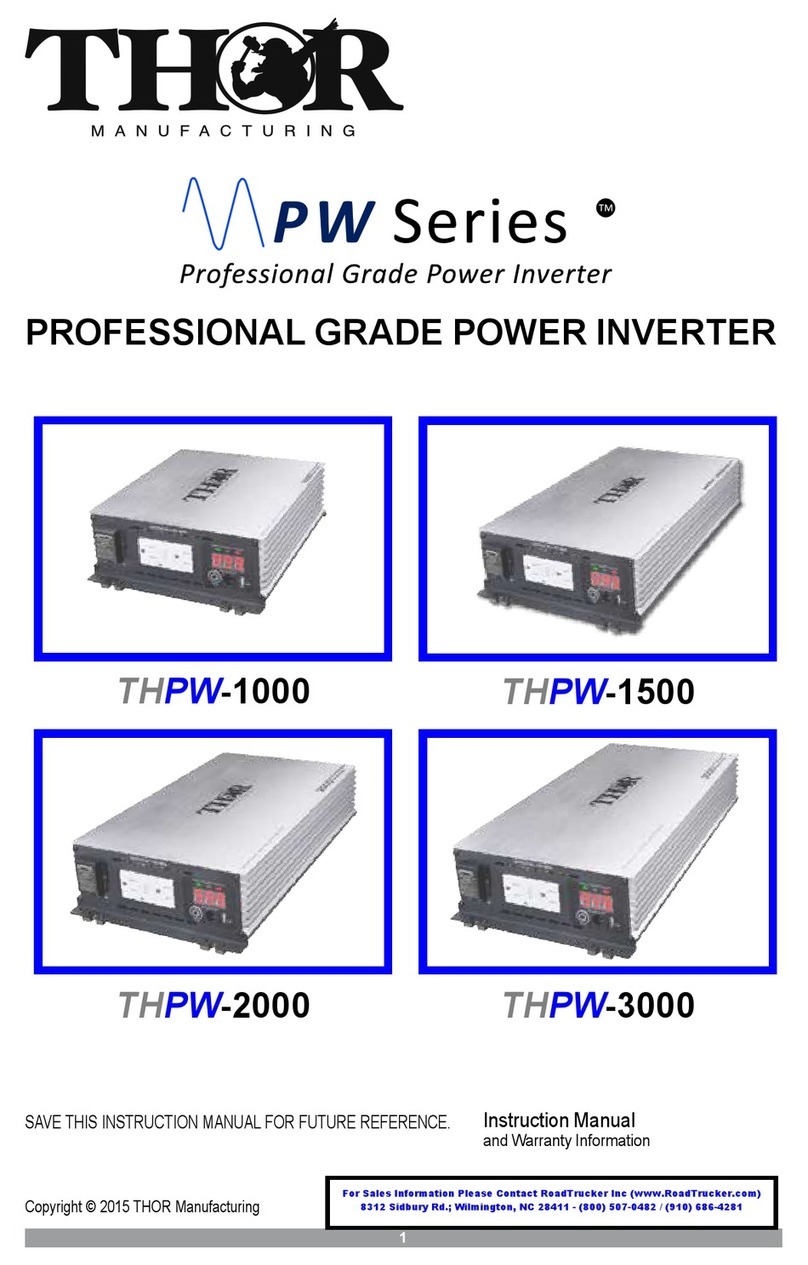
THOR
THOR THPW-1000 User manual

THOR
THOR THPS-600R-12 User manual
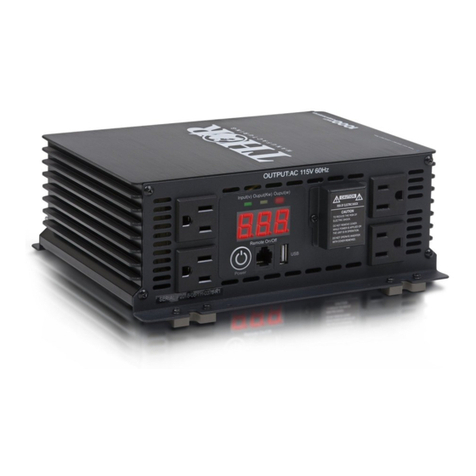
THOR
THOR MS Series User manual

THOR
THOR TH225 Instruction Manual

THOR
THOR TH1000 Instruction Manual
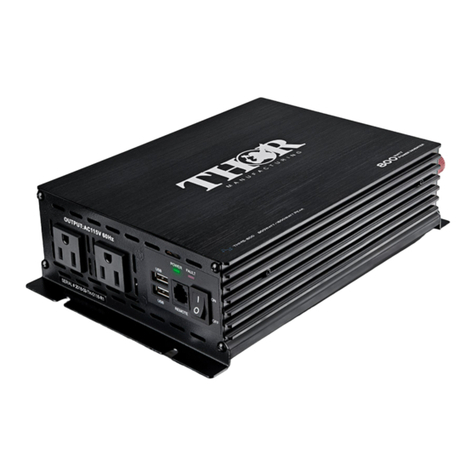
THOR
THOR PPI Series User manual

THOR
THOR THPS-300-24 User manual

THOR
THOR THPW1500-ETL Instruction Manual
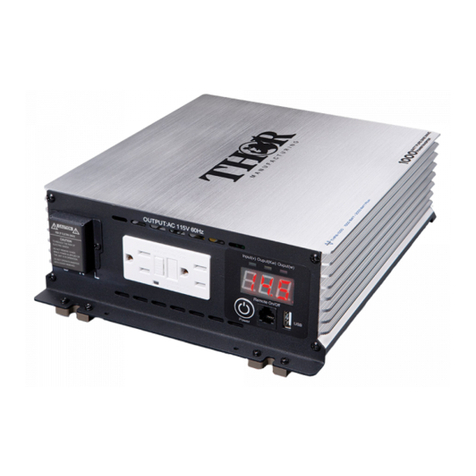
THOR
THOR PW Series User manual
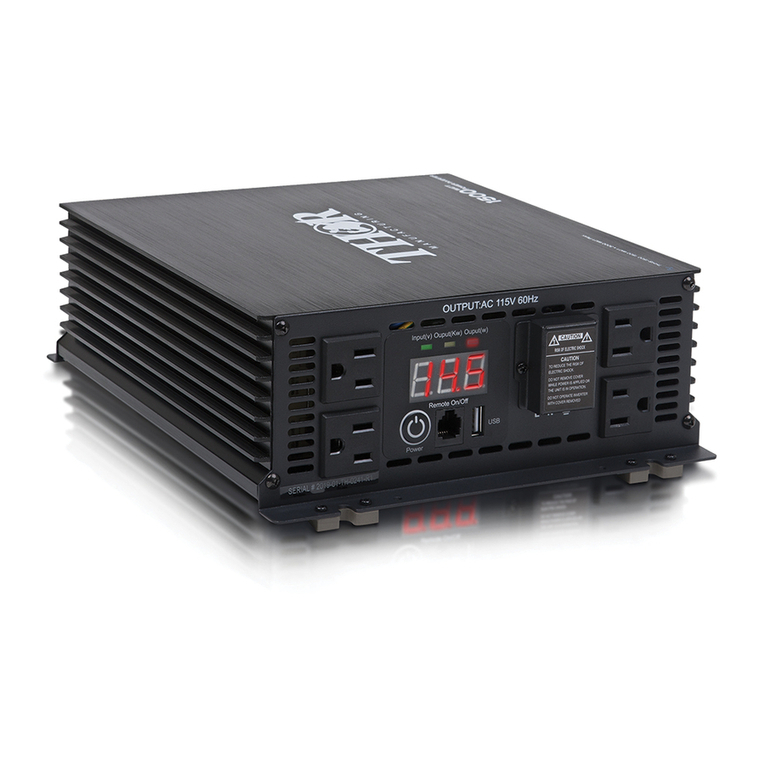
THOR
THOR THMS-1000 User manual
